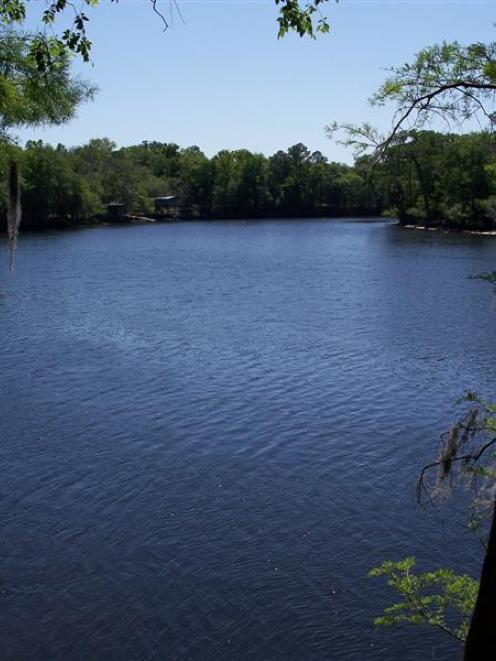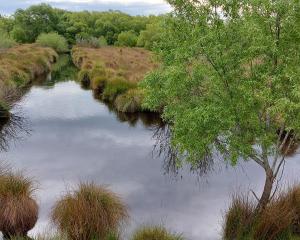
And galvanised by the song, environmentalists and legislators are fighting to keep the stream unspoiled amid thirsty Florida's development.
"Way down upon the Suwannee River . . ."
"That song is something that everybody learns as a kid . . . and it just sticks in their mind," says Chris Brown, a canoe outfitter on the river.
"I think that's the biggest thing that draws people here."
Visitors can visit a museum dedicated to the composer, Stephen Foster; a state park and some Florida schools are also named for the river's greatest benefactor.
What's ironic is that Foster, a Pittsburgh native who died destitute in 1864, never laid eyes on the Suwannee.
The name - which Foster picked out of an atlas and intentionally misspelled as "Swanee" - happened to fit with the cadence of the minstrel song Old Folks at Home, that he was writing in 1851.
The tune has become iconic - enduring and evolving through the years.
Adopted as Florida's state song in 1935, it got a wholesale rewrite this year to get rid of racially insensitive, antebellum lyrics.
The revisions tamped down a movement among some state lawmakers to get rid of the tune completely.
It's now one of two official state songs.
If Foster had visited the Suwannee before he put pen to paper, he would have found it much the way it appears today: free-flowing and clean with scant development along Spanish moss-draped banks.
All those alligators are still lying as still as statues in the sun, green turtles are stacked up on logs and exotic birds fish among the knobby cypress knees.
The whitewater rapids still roar up at Big Shoals.
School kids on summer break still splash in the cold, crystal waters of the hundreds of natural springs tucked into folds along the river and its tributaries, much the way children surely did in Foster's day.
And sturgeon with their prehistoric-looking armour still leap high out of the water, occasionally catching an unsuspecting boater on the head.
"It's an extraordinary place to tap into the best of what's left of the real natural Florida," says John Moran, a noted nature photographer.
Moran has taken to paraphrasing famed naturalist Archie Carr in describing his beloved Suwannee as "something real to hold on to in a state all broken out with man".
Bubbling up from the Okefenokee Swamp in southern Georgia, the Suwannee River makes a lazy loop through 400km of mostly rural north Florida before opening wide into the Gulf of Mexico next to a national wildlife refuge and a pretty little town called Suwannee.
David Still, executive director of the Suwannee River Water Management District, the independent government agency that oversees the area's water resources, says it's one of the cleanest, least-obstructed large waterways in the United States.
"This is a river where nature is the boss," Still says.
"She controls what happens along that river. We haven't dyked it, dammed it, ditched it or bermed it. So what you see in many parts of the river is how it has been for many, many years.
"That, to me, is what makes the Suwannee such an incredible natural resource."
Thousands of people visit every year, many drawn here by the familiar tune and then hooked by the unspoiled natural beauty that's a world away but just a few hours' drive from the mighty Mouse that drives the state's tourism engine.
Brown, whose canoe outpost is at Manatee Springs, says more than half of his customers now are foreign tourists, especially those who recognise the famous song as something so truly American that they just had to come see the source.
"They're just amazed that we have all this nature still available," Brown says.
"Where they're coming from, their lakes and rivers are so developed that they have no place to go. All you see is houses and backyards.
"They come here, and they're just amazed that they can come 10 or 15 miles [16km-24km] down the river and not see a house."
The Florida government has in this decade turned most of the Suwannee into one long state park, making it possible for canoeists to cover 274km of the river while stopping every 15km to 25km to camp for free on state-owned land.
Some of the outfitters marketing the Suwannee River Wilderness Trail drive in to pick up camping gear and move it downriver to the next site while visitors are paddling.
Also working in the Suwannee's favour has been geography - the river doesn't run through or near any large city - and a large contingent of passionate supporters who have fought development and so far helped stave off water grabs by the state's parched cities.
Cynthia Barnett, a fifth-generation Floridian who examined the state's water woes in her book Mirage: Florida and the Vanishing Water of the Eastern US, thinks Foster's unwitting creation of an American icon in the Suwannee River has helped motivate more residents to stand up and fight for it as the threats arise.
In 2003, they shouted down lawmakers in public hearings across the state regarding possible long-distance transfer of north Florida's water supplies.
But Barnett and others fear the Suwannee may be incrementally succumbing to the same problems with pollution and development that spoiled other natural areas of the nation's fourth-largest state, notably the Everglades.
Those who work and live on the spring-fed river have noted diminished flow due to increased groundwater pumping, as well as signs of increasing pollution from farming and wastewater run-off.
"This region simply doesn't have the political power of a central Florida or a south Florida, and water supply always comes down to power," Barnett says.
"So I do worry about that more than anything."












